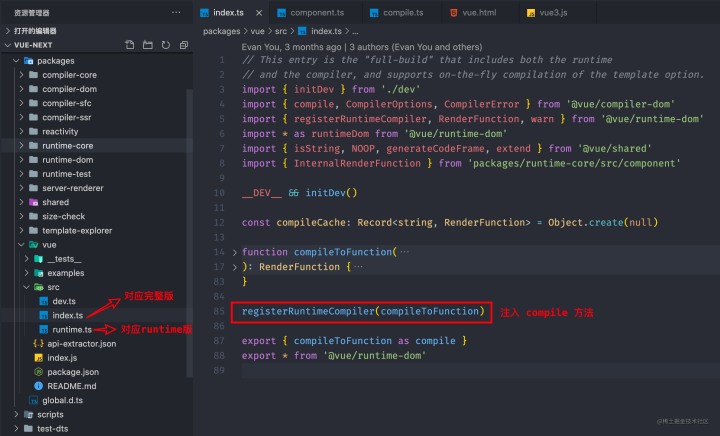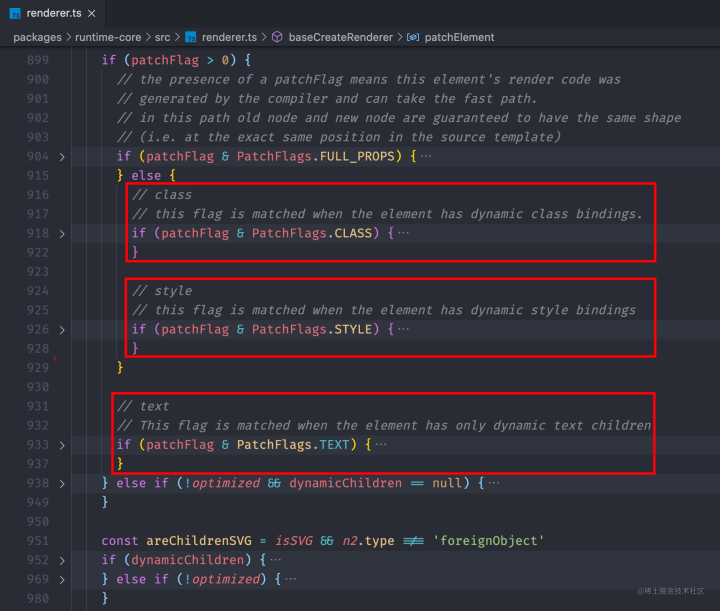今天的文章打算学习下 Vue3 下的模板编译与 Vue2 下的差异,以及 VDOM 下 Diff 算法的优化。
编译入口
了解过 Vue3 的同学肯定知道 Vue3 引入了新的组合 Api,在组件 mount 阶段会调用 setup 方法,之后会判断 render 方法是否存在,如果不存在会调用 compile 方法将 template 转化为 render。
// packages/runtime-core/src/renderer.ts
const mountComponent = (initialVNode, container) => {
const instance = (
initialVNode.component = createComponentInstance(
// ...params
)
)
// 调用 setup
setupComponent(instance)
}
// packages/runtime-core/src/component.ts
let compile
export function registerRuntimeCompiler(_compile) {
compile = _compile
}
export function setupComponent(instance) {
const Component = instance.type
const { setup } = Component
if (setup) {
// ...调用 setup
}
if (compile && Component.template && !Component.render) {
// 如果没有 render 方法
// 调用 compile 将 template 转为 render 方法
Component.render = compile(Component.template, {...})
}
}
这部分都是 runtime-core 中的代码,之前的文章有讲过 Vue 分为完整版和 runtime 版本。如果使用 vue-loader 处理 .vue 文件,一般都会将 .vue 文件中的 template 直接处理成 render 方法。
// 需要编译器
Vue.createApp({
template: '<div>{{ hi }}</div>'
})
// 不需要
Vue.createApp({
render() {
return Vue.h('div', {}, this.hi)
}
})
完整版与 runtime 版的差异就是,完整版会引入 compile 方法,如果是 vue-cli 生成的项目就会抹去这部分代码,将 compile 过程都放到打包的阶段,以此优化性能。runtime-dom 中提供了 registerRuntimeCompiler 方法用于注入 compile 方法。

主流程
在完整版的 index.js 中,调用了 registerRuntimeCompiler 将 compile 进行注入,接下来我们看看注入的 compile 方法主要做了什么。
// packages/vue/src/index.ts
import { compile } from '@vue/compiler-dom'
// 编译缓存
const compileCache = Object.create(null)
// 注入 compile 方法
function compileToFunction(
// 模板
template: string | HTMLElement, // 编译配置
options?: CompilerOptions
): RenderFunction {
if (!isString(template)) {
// 如果 template 不是字符串
// 则认为是一个 DOM 节点,获取 innerHTML
if (template.nodeType) {
template = template.innerHTML
} else {
return NOOP
}
}
// 如果缓存中存在,直接从缓存中获取
const key = template
const cached = compileCache[key]
if (cached) {
return cached
}
// 如果是 ID 选择器,这获取 DOM 元素后,取 innerHTML
if (template[0] === '#') {
const el = document.querySelector(template)
template = el ? el.innerHTML : ''
}
// 调用 compile 获取 render code
const { code } = compile(
template,
options
)
// 将 render code 转化为 function
const render = new Function(code)();
// 返回 render 方法的同时,将其放入缓存
return (compileCache[key] = render)
}
// 注入 compile
registerRuntimeCompiler(compileToFunction)
在讲 Vue2 模板编译的时候已经讲过,compile 方法主要分为三步,Vue3 的逻辑类似:
- 模板编译,将模板代码转化为 AST;
- 优化 AST,方便后续虚拟 DOM 更新;
- 生成代码,将 AST 转化为可执行的代码;
参考vue实战视频讲解:进入学习
// packages/compiler-dom/src/index.ts
import { baseCompile, baseParse } from '@vue/compiler-core'
export function compile(template, options) {
return baseCompile(template, options)
}
// packages/compiler-core/src/compile.ts
import { baseParse } from './parse'
import { transform } from './transform'
import { transformIf } from './transforms/vIf'
import { transformFor } from './transforms/vFor'
import { transformText } from './transforms/transformText'
import { transformElement } from './transforms/transformElement'
import { transformOn } from './transforms/vOn'
import { transformBind } from './transforms/vBind'
import { transformModel } from './transforms/vModel'
export function baseCompile(template, options) {
// 解析 html,转化为 ast
const ast = baseParse(template, options)
// 优化 ast,标记静态节点
transform(ast, {
...options,
nodeTransforms: [
transformIf,
transformFor,
transformText,
transformElement,
// ... 省略了部分 transform
],
directiveTransforms: {
on: transformOn,
bind: transformBind,
model: transformModel
}
})
// 将 ast 转化为可执行代码
return generate(ast, options)
}
计算 PatchFlag
这里大致的逻辑与之前的并没有多大的差异,主要是 optimize 方法变成了 transform 方法,而且默认会对一些模板语法进行 transform。这些 transform 就是后续虚拟 DOM 优化的关键,我们先看看 transform 的代码 。
// packages/compiler-core/src/transform.ts
export function transform(root, options) {
const context = createTransformContext(root, options)
traverseNode(root, context)
}
export function traverseNode(node, context) {
context.currentNode = node
const { nodeTransforms } = context
const exitFns = []
for (let i = 0; i < nodeTransforms.length; i++) {
// Transform 会返回一个退出函数,在处理完所有的子节点后再执行
const onExit = nodeTransforms[i](node, context)
if (onExit) {
if (isArray(onExit)) {
exitFns.push(...onExit)
} else {
exitFns.push(onExit)
}
}
}
traverseChildren(node, context)
context.currentNode = node
// 执行所以 Transform 的退出函数
let i = exitFns.length
while (i--) {
exitFns[i]()
}
}
我们重点看一下 transformElement 的逻辑:
// packages/compiler-core/src/transforms/transformElement.ts
export const transformElement: NodeTransform = (node, context) => {
// transformElement 没有执行任何逻辑,而是直接返回了一个退出函数
// 说明 transformElement 需要等所有的子节点处理完后才执行
return function postTransformElement() {
const { tag, props } = node
let vnodeProps
let vnodePatchFlag
const vnodeTag = node.tagType === ElementTypes.COMPONENT
? resolveComponentType(node, context)
: `"${tag}"`
let patchFlag = 0
// 检测节点属性
if (props.length > 0) {
// 检测节点属性的动态部分
const propsBuildResult = buildProps(node, context)
vnodeProps = propsBuildResult.props
patchFlag = propsBuildResult.patchFlag
}
// 检测子节点
if (node.children.length > 0) {
if (node.children.length === 1) {
const child = node.children[0]
// 检测子节点是否为动态文本
if (!getStaticType(child)) {
patchFlag |= PatchFlags.TEXT
}
}
}
// 格式化 patchFlag
if (patchFlag !== 0) {
vnodePatchFlag = String(patchFlag)
}
node.codegenNode = createVNodeCall(
context,
vnodeTag,
vnodeProps,
vnodeChildren,
vnodePatchFlag
)
}
}
buildProps 会对节点的属性进行一次遍历,由于内部源码涉及很多其他的细节,这里的代码是经过简化之后的,只保留了 patchFlag 相关的逻辑。
export function buildProps(
node: ElementNode, context: TransformContext, props: ElementNode['props'] = node.props
) {
let patchFlag = 0
for (let i = 0; i < props.length; i++) {
const prop = props[i]
const [key, name] = prop.name.split(':')
if (key === 'v-bind' || key === '') {
if (name === 'class') {
// 如果包含 :class 属性,patchFlag | CLASS
patchFlag |= PatchFlags.CLASS
} else if (name === 'style') {
// 如果包含 :style 属性,patchFlag | STYLE
patchFlag |= PatchFlags.STYLE
}
}
}
return {
patchFlag
}
}
上面的代码只展示了三种 patchFlag 的类型:
- 节点只有一个文本子节点,且该文本包含动态的数据(
TEXT = 1)
<p>name: {{name}}</p>
- 节点包含可变的 class 属性(
CLASS = 1 << 1)
<div :class="{ active: isActive }"></div>
- 节点包含可变的 style 属性(
STYLE = 1 << 2)
<div :style="{ color: color }"></div>
可以看到 PatchFlags 都是数字 1 经过 左移操作符 计算得到的。
export const enum PatchFlags {
TEXT = 1, // 1, 二进制 0000 0001
CLASS = 1 << 1, // 2, 二进制 0000 0010
STYLE = 1 << 2, // 4, 二进制 0000 0100
PROPS = 1 << 3, // 8, 二进制 0000 1000
...
}
从上面的代码能看出来,patchFlag 的初始值为 0,每次对 patchFlag 都是执行 | (或)操作。如果当前节点是一个只有动态文本子节点且同时具有动态 style 属性,最后得到的 patchFlag 为 5(二进制:0000 0101)。
<p :style="{ color: color }">name: {{name}}</p>
patchFlag = 0
patchFlag |= PatchFlags.STYLE
patchFlag |= PatchFlags.TEXT
// 或运算:两个对应的二进制位中只要一个是1,结果对应位就是1。
// 0000 0001
// 0000 0100
// ------------
// 0000 0101 => 十进制 5

我们将上面的代码放到 Vue3 中运行:
const app = Vue.createApp({
data() {
return {
color: 'red',
name: 'shenfq'
}
},
template: `<div> <p :style="{ color: color }">name: {{name}}</p> </div>`
})
app.mount('#app')
最后生成的 render 方法如下,和我们之前的描述基本一致。

render 优化
Vue3 在虚拟 DOM Diff 时,会取出 patchFlag 和需要进行的 diff 类型进行 &(与)操作,如果结果为 true 才进入对应的 diff。

还是拿之前的模板举例:
<p :style="{ color: color }">name: {{name}}</p>
如果此时的 name 发生了修改,p 节点进入了 diff 阶段,此时会将判断 patchFlag & PatchFlags.TEXT ,这个时候结果为真,表明 p 节点存在文本修改的情况。

patchFlag = 5
patchFlag & PatchFlags.TEXT
// 或运算:只有对应的两个二进位都为1时,结果位才为1。
// 0000 0101
// 0000 0001
// ------------
// 0000 0001 => 十进制 1
if (patchFlag & PatchFlags.TEXT) {
if (oldNode.children !== newNode.children) {
// 修改文本
hostSetElementText(el, newNode.children)
}
}
但是进行 patchFlag & PatchFlags.CLASS 判断时,由于节点并没有动态 Class,返回值为 0,所以就不会对该节点的 class 属性进行 diff,以此来优化性能。

patchFlag = 5
patchFlag & PatchFlags.CLASS
// 或运算:只有对应的两个二进位都为1时,结果位才为1。
// 0000 0101
// 0000 0010
// ------------
// 0000 0000 => 十进制 0
总结
其实 Vue3 相关的性能优化有很多,这里只单独将 patchFlag 的十分之一的内容拿出来讲了,Vue3 还没正式发布的时候就有看到说 Diff 过程会通过 patchFlag 来进行性能优化,所以打算看看他的优化逻辑,总的来说还是有所收获。
标签:node,const,render,patchFlag,compile,编译,template,Vue3,模板 From: https://www.cnblogs.com/yyds2026/p/16857363.html